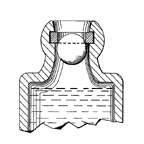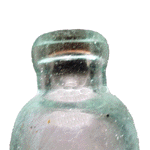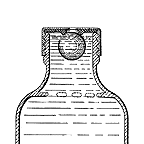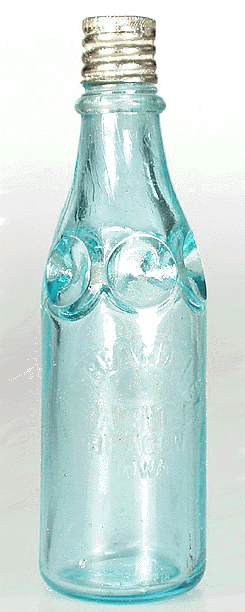You are using an out of date browser. It may not display this or other websites correctly.
You should upgrade or use an alternative browser.
You should upgrade or use an alternative browser.
What type of closure is this?
- Thread starter jkern
- Start date
druggistnut
Well-Known Member
Jim,
I have had a lot of Spitzley hutches over the years and they were ALL hutchinson closures. I never saw another type of closure on one.
I believe someone stuck that marble in that bottle- it doesn't belong there, in my opinion.
Bill
I have had a lot of Spitzley hutches over the years and they were ALL hutchinson closures. I never saw another type of closure on one.
I believe someone stuck that marble in that bottle- it doesn't belong there, in my opinion.
Bill
surfaceone
Well-Known Member
- Joined
- Dec 9, 2008
- Messages
- 11,161
- Reaction score
- 24
- Points
- 0
Evening Jim and Bill,
I looked at this and thought Thasmo or Roorbach at first blink. The throats and gasket /washer pockets on those did not seem to agree with the Spritzley on greedbay.
 "Thomas or Thasmo Closure, circ: 1895-1905, Occurs on 25 bottles,
"Thomas or Thasmo Closure, circ: 1895-1905, Occurs on 25 bottles,
Invented by: Frederic R. H. Thomas,
American Patent: April 23, 1895, Number: 537,946,
American Patent: December 10, 1895, Number: 551,102,
This closure was another improvement to the glass ball stopper that sealed against a rubber disk in the lip of the bottle. The improvement was that the marble jammed in the shoulder of the bottle when the contents were poured out."
 "Roorbach 1885 or Twitchell Floating Ball Closure, circ: 1885-1905, Occurs on 76 bottles,
"Roorbach 1885 or Twitchell Floating Ball Closure, circ: 1885-1905, Occurs on 76 bottles,
Invented by: William L. Roorbach, Selden Twitchell,
American Patent: June 23, 1885, Number: 320,701,
American Patent: August 4, 1885, Number: 323,737,
American Patent: April 10, 1888, Number: 380,957
This stopper was an improvement to Roorbach's 1883 patent. The improvement consisted of a floating hollow composite rubber ball that pressed against a rubber washer imbedded in the lip of the bottle. Examples of this closure can be found across the United States and bottles often have the patent dates embossed in a ring around the base of the bottle and have the letters, "F. B. S." for "Floating Ball Stopper" on the base. The stopper was marketed by Twitchell & Brother, a bottlers supply company of Philadelphia." Thanks to Tod.
The seller, with his single picture and lackluster description; "There is a marble stuck in the opening which I have not attempt to take out." Doesn't say what kind of marble and I could not make it out in the photo.
I'm with Bill on this. I think it's a quart Hutchinson, with perhaps a clay marble lodged in it.
Bill, I'd really like to see your Sprizleys.
I also don't think its a Beardsley closure. I never heard of a Beardsley Closure before. I think this may be a new discovery by Tod.
 "Beardsley Closure, circ: 1885, Occurs on 1 bottle,
"Beardsley Closure, circ: 1885, Occurs on 1 bottle,
Invented by: William Beardsley,
American Patent: May 12, 1885, Number: 317,705,
This closer was only used by its inventor William Beardsley. It was also based on a glass marble that sealed the contents. In this case, the stopper sealed against a screw on cap that had a hole in it. There were indentations on the side of the bottle that held the marble as the contents were being poured from the bottle." Thanks, Tod.
Get a load of the Beardsley bottle!
 From.
From.
I have so got the hotz for that Beardsley! Who has one?

I looked at this and thought Thasmo or Roorbach at first blink. The throats and gasket /washer pockets on those did not seem to agree with the Spritzley on greedbay.

Invented by: Frederic R. H. Thomas,
American Patent: April 23, 1895, Number: 537,946,
American Patent: December 10, 1895, Number: 551,102,
This closure was another improvement to the glass ball stopper that sealed against a rubber disk in the lip of the bottle. The improvement was that the marble jammed in the shoulder of the bottle when the contents were poured out."

Invented by: William L. Roorbach, Selden Twitchell,
American Patent: June 23, 1885, Number: 320,701,
American Patent: August 4, 1885, Number: 323,737,
American Patent: April 10, 1888, Number: 380,957
This stopper was an improvement to Roorbach's 1883 patent. The improvement consisted of a floating hollow composite rubber ball that pressed against a rubber washer imbedded in the lip of the bottle. Examples of this closure can be found across the United States and bottles often have the patent dates embossed in a ring around the base of the bottle and have the letters, "F. B. S." for "Floating Ball Stopper" on the base. The stopper was marketed by Twitchell & Brother, a bottlers supply company of Philadelphia." Thanks to Tod.
The seller, with his single picture and lackluster description; "There is a marble stuck in the opening which I have not attempt to take out." Doesn't say what kind of marble and I could not make it out in the photo.
I'm with Bill on this. I think it's a quart Hutchinson, with perhaps a clay marble lodged in it.
Bill, I'd really like to see your Sprizleys.
I also don't think its a Beardsley closure. I never heard of a Beardsley Closure before. I think this may be a new discovery by Tod.

Invented by: William Beardsley,
American Patent: May 12, 1885, Number: 317,705,
This closer was only used by its inventor William Beardsley. It was also based on a glass marble that sealed the contents. In this case, the stopper sealed against a screw on cap that had a hole in it. There were indentations on the side of the bottle that held the marble as the contents were being poured from the bottle." Thanks, Tod.
Get a load of the Beardsley bottle!

I have so got the hotz for that Beardsley! Who has one?

SODAPOPBOB
Well-Known Member
- Joined
- Mar 10, 2010
- Messages
- 11,502
- Reaction score
- 49
- Points
- 0
The following is from "The Historic Bottle Website" by Bill Lindsey and others ...
The picture below shows a Hutchinson type bottle that used the Roorbach ball stopper. The bottles were produced by a method that required the use of an applied finish until well into the 20th century which is long after virtually all other bottle types were being mouth-blown with tooled finishes. According to one author the mouth-blown bottles were produced as follows ...
After being mold blown the bottles were sheared at the neck and allowed to cool. Then a glass marble, made from glass of a hardness twice that of the bottle was dropped into it. The bottle was then re-heated and the neck welded on (finish applied), so containing the marble (Goodacre 1995).

The picture below shows a Hutchinson type bottle that used the Roorbach ball stopper. The bottles were produced by a method that required the use of an applied finish until well into the 20th century which is long after virtually all other bottle types were being mouth-blown with tooled finishes. According to one author the mouth-blown bottles were produced as follows ...
After being mold blown the bottles were sheared at the neck and allowed to cool. Then a glass marble, made from glass of a hardness twice that of the bottle was dropped into it. The bottle was then re-heated and the neck welded on (finish applied), so containing the marble (Goodacre 1995).

Attachments
SODAPOPBOB
Well-Known Member
- Joined
- Mar 10, 2010
- Messages
- 11,502
- Reaction score
- 49
- Points
- 0
Wheelah23
Well-Known Member
That ebay bottle never used a marble. I'm sure it was a regular hutchinson closure. Then somebody squeezed a marble into the neck to try and fool people, or it fell in and they simply couldn't get it out. I'd imagine it's stuck real good by now.
stumpknocker
Well-Known Member
- Joined
- Jan 6, 2010
- Messages
- 457
- Reaction score
- 0
- Points
- 0
The following is from "The Historic Bottle Website" by Bill Lindsey and others ...
The picture below shows a Hutchinson type bottle that used the Roorbach ball stopper. The bottles were produced by a method that required the use of an applied finish until well into the 20th century which is long after virtually all other bottle types were being mouth-blown with tooled finishes. According to one author the mouth-blown bottles were produced as follows ...
After being mold blown the bottles were sheared at the neck and allowed to cool. Then a glass marble, made from glass of a hardness twice that of the bottle was dropped into it. The bottle was then re-heated and the neck welded on (finish applied), so containing the marble (Goodacre 1995).
Bob your information is not in context with the information provided by Bill Lindsey on The Historic Bottle Website. The Roorbach closure has no connection to the Hutchinson Closure at all. Have you even read any of the information on the website? Bill states that the Stewart closure was most like the Roorbach but had just enough difference that a separate patent was issued.
http://www.sha.org/bottle/websitemap.htm
Connor has said it best. This is just a Hutchinson Soda Bottle that someone through a marble into. Thus the two pieces are married.
Similar threads
- Replies
- 21
- Views
- 7K
- Replies
- 1
- Views
- 938
Latest posts
-
-
Small Town Tennessee Slug Plate Bottles Needed
- Latest: WestTNBottle
-
-
-
Latest threads
-
-
-
R. E. L. Gunter flask Enfield NC
- Started by bdahlem
- Replies: 1
-
Tucker Philadelphia Bottle
- Started by canalsendantiques
- Replies: 2
-
-
Info on 1920s Flapper 9 oz amber bottle
- Started by ROC.NYbottles
- Replies: 4



